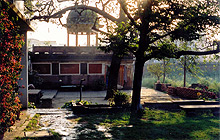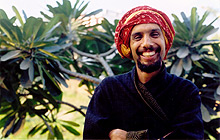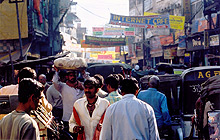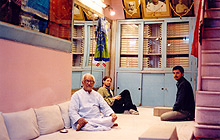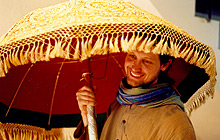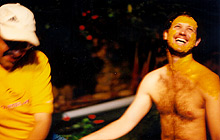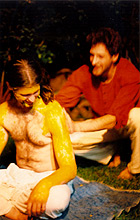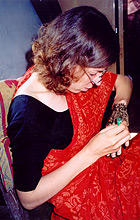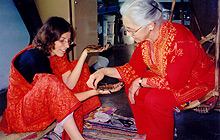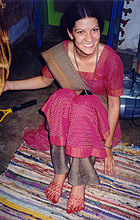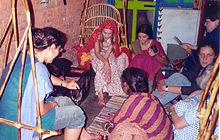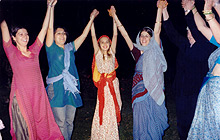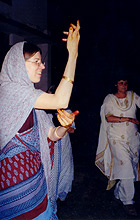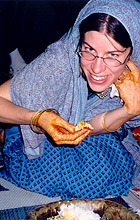 Please be reminded that these photographs are copyrighted images and are to be viewed in connection to this site only. You do not have permission to rip these off of this site (even for what you may consider as "personal use") or to alter them in any way. Permission is not granted for any other use than viewing here, and those violating international copyright laws will be subject to prosecution. You must obtain handwritten permission by the artist. (Note: If you want to get the whole story of arrival in India and the month we spent in Calcutta, Delhi, Chandigarh, and Lucknow prior to the wedding, you would need to check out the India story/photos that are also located in the "Miranda's Dirt" section) The sun was just beginning to rise when Chris and I stumbled out of the overnight train with our bags, reaching Varanasi on Monday, Feb. 23rd. After steaming cups of Chai under a spreading Banyan tree we sat and waited for our friend Stefan who was also coming to Varanasi by train (He and Chris had attended Woodstock School in India.) Chris and I had been researching Indian wedding traditions and making countless email and phone arrangements for 7 weeks while traveling, but it was folks like Stefan who ended up with much of the real grunt work over the next 4 days. Wedding celebrations in India are traditionally a complex and lengthy affair, usually lasting a week. The participation of family is crucial. Each member has different duties or responsibilities to perform within the actual ceremony or the celebrations surrounding it. So a major problem with doing an Indian wedding was simply that my own parents couldn't make it to India. It was going to be too difficult to get them there in one piece, happy and unflustered, able to enjoy the experience. I needed to be "adopted" by Indian parents and Chris arranged that good friends of his would fill the role. Connie (originally from California) and Rajiv (of Indian descent) would end up being the most perfect parents I could have hoped for. My Indian dad, Rajiv came down with Hepatitis a few days before we arrived, so he had to take it easy. (Photo: Miranda Stone) There is no such thing as "one way to do an Indian wedding." The traditions of importance are based largely on the culture where the family resides, and changes are made according to what is deemed important to each family. The elders and attending pujari (priest), rather than the bride and groom, make the decisions to insure that rituals are performed as they should be for a proper and spiritually blessed (auspicious) union. A wedding in Varanasi will look different than the Bengali wedding Chris and I attended in Kolkota. In our case, we took on more of the decision- making (than tradition dictates) and made changes according to our spiritual beliefs with the desire to honor our guests, who would be representing different religious communities. Many discussions with friends and family led to research of Hindu marriage rituals and traditions that helped us define what should be done with our wedding, but there were other critical factors as well. Both Chris and I identify as followers of Christ and within Hindu context the phrase "Krist Bhakta" (Devotee of Christ) is a good way to describe our hearts. Chris had grown up in Nepal and India and was already traveling around the world performing many of the bhajans (devotional songs of India written by Krist Bhakta's); whereas I had discovered how deeply moved a person could be through expressing their devotion using another language. There was a longing in both of us to have our wedding embody the richness and emotive traditions of India linked with our spiritual devotion and community. The most natural thing to do was to contact an ashram (Indian spiritual retreat center) on the outskirts of Varanasi run by a monk who had written many of the beautiful songs that Chris was already singing and recording. Surrounded by large trees and quiet gardens, this ashram had already played an important role in Chris' life back in 1999 when he had spent 10 days in fasting and prayer for direction on whether he should pursue either a wife, or the gift of celibacy. To be honest, I can't remember what kind of answer he discovered after those ten days, but obviously the celibacy ideal didn't stick. The uniqueness of the ashram is reflected in its Catholic, charismatic, and Hindu cultural influences, and our request to have the wedding rituals on their grounds was met with enthusiasm despite the fact that both Chris and I grew up in families with mostly Protestant backgrounds. As the wedding day approached, we sent out a special email to those who would be attending. Among those invited were Hindus of various religious traditions, those who considered themselves to be Hindu followers of Christ (Krist Bhaktas), some who considered themselves to be followers of Christ or "Christians" within various traditions, and still others of varying backgrounds. This email, sent in advance, would give everyone an idea of what to expect, since there would be a few changes in the traditional rituals. I always find it helpful to define terms, since language and our understanding of words can shift drastically, even within a year. The term "Hindu" is one of those words that repeatedly comes up with mixed understandings. It is even less understood than words like "Jewish," "Christian," or "Muslim." A person may be considered Jewish, but have no real connection to religious practice. But many people do not realize that, like a good non-religious Jew, a person may be considered a "Hindu," even a "good Hindu" without worshiping any of the popular gods or goddesses. Goodness is recognized far more by how well they are carrying out their social duties to family (as husband, wife, son or daughter etc.) There are many "good Hindus" who entirely disregard personal devotion (bhakti) to a particular god, and instead focus more on the philosophy found within the ancient scriptures or in the practice of yoga. Still other "good Hindus" consider true religion to be summed up in service and love to the poor. There's a constant feeling of gridlock on the old streets of Varanasi. Leave the car at home. It's faster to walk. (Photo: Miranda Stone) The Indian bride's attire changes from region to region, but a red sari is a common choice. The richly embellished Lehnga Choli (the full skirt and blouse with veil) has almost replaced the sari when it comes to North Indian weddings. There should be bangles and lots of jewelry and often a veil of some sort. During the wedding we attended in Kolkota (I have now found over 5 spellings for Calcutta but I'll stick with this one!) they used elaborate white headdresses that appeared to be made out of paper (but that's understood to be a Bengali tradition). We had purchased bangles and shoes in Lucknow, and toe rings needed to be found (in our case, a gift to be given to me by Chris's brother Tom). But I was still without a sari. Then we needed to address the issue of jewelry, which was often rented and very heavy, cumbersome and gaudy. We had three days. An older shopkeeper in his clean and well-managed sari shop where we found the wedding duppata. (Photo: Miranda Stone) On Tuesday, I did a fruit fast. This was also the day that my Indian mom had arranged for our massages. At around nine in the morning a husband/wife team appeared, waiting patiently beneath the huge tree at Connie and Rajiv's. Connie sent the husband down the road to where Chris was staying for the week, while I was brought upstairs to a quiet room where I attempted to communicate with the wife in my limited Hindi. It was a wonderful hour of relaxation that I feel would have better served Connie, who I watched hard at work the entire time. In fact, what amazed me, and brought so much wonder during that week was how much love, effort and grace was poured out on us by our friends. Even by those who we barely knew. One couple (including Chris's mom) had flown in from Albany. Others, who were residents in South India, spent days on the train. Plane ticket to India = $ 1500 Embroidered umbrella = $ 500 Photo of my boy holding the umbrella = priceless. (Photo: Miranda Stone) Chris and I went back out to the market in the afternoon and searched yet again for a sari, but I still couldn't find the kind that I had imagined. Having seen what I wanted in Kolkota only a month earlier, I was kicking myself now that my search was proving fruitless two days before the wedding ceremony. (Apparently, my tastes have revealed themselves to favor Bengali food and sari designs.) In one shop we were repeatedly encouraged by the owners to buy a rather painstakingly made umbrella. Instead, we took photos. We found the duppata (veil) that I needed to wear for the ceremony at one of the smaller established sari shops in the old market. That evening, Chris and I both had the Haldi Lagana ceremony. Sadly, I have no pictures of mine, but Stefan and several other guests took some great pictures with Chris. It was a beautiful time of quiet reflection, mixed with mirth. Haldi (Tumeric) is mixed into a paste with water and a little mustard oil, and then friends and relatives anoint the bride and groom (who both have their own separate gatherings.) By the end of the night, Chris was quite smeared with the haldi, but I had it mostly rubbed on my face, arms, and feet in a more ritualistic gesture of cleansing and blessing, as women friends said prayers and beautiful words of blessing. The application of beautiful designs using henna paste (mehendi) usually takes place a day or two before the wedding ceremony. Applying henna with the right hand was fine. Using the left hand required more patience. (Photo: Cynthia) Of course, the problem with mehendi is that when your hands are totally covered in wet henna, and your feet are too, you can't really do anything for yourself, so friends and family have to feed you or help you blow your nose! Just before leaving for a boat ride on the Ganga river with Chris, Cynthia (Chris's mom) dropped in to help with the mehendi activities. She had just arrived that morning by train. The night before a wedding, all the womenfolk on the bride's side will gather together for a "ladies night" of music, dance and a meal. (Sometimes the groom or his friends, dressed up as women, will try to "crash" the party!) A few women came early and sat in the living room while Connie prepared food with the help of her Didi. (Didi means "older sister"). Later, the Didi painted designs with red dye on the feet of the guests as decoration to celebrate the approaching marriage ceremony. A few hours earlier one of Connie's friends had offered to lend me her beautiful red sari. I now had something to wear to the wedding... I was relieved. During the week of wedding celebrations, it's not uncommon to have this reapplied daily. Everywhere you look in India, the use of creativity, design and embellishment gushes from the hands of the common man. You'll find it in the alta dye on a woman's feet, or the painted decorations on a TATA truck. If you rise early enough in the morning you might witness a woman in her daily ritual of making designs (rangoli) in front of her door with rice flour. Right before the "Ladies Sangeet" (night of music, dancing and feasting) more red dye is applied. (Photo: Dean)
After the dancing, there was a simple meal of spiced vegetables. A damp clay pot held the customary yogurt (dahi) to go along with the meal. I don't think I'll quit my folk-singing career to become a Bollywood dancer...
(Photo: Cynthia/Friend?) Becki (my very-soon-to-be sister-in-law) ladles out rice onto leaf plates, the more environmentally effective Indian version of the paper plate. (Photo: Cynthia)
The true way to eat Indian food. I never eat with a knife and fork anymore. unless, of course, it's a "western- style" meal (Photo: Cynthia)
To Be Continued... Please check back often! Copyright © Earthdress Productions. All Rights Reserved.
|
